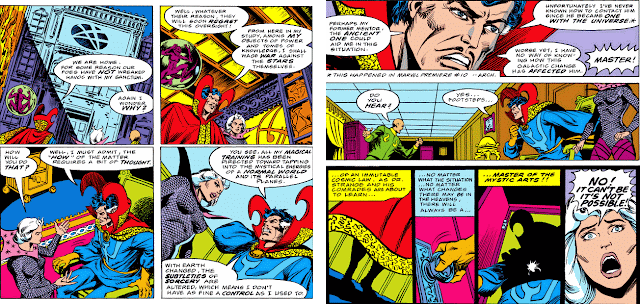While browsing the comics rack, there are occasions when an issue's cover might have one feeling compelled to pick up a mag out of sheer curiosity. In mid-1967, there were surely more than a few readers who couldn't resist finding out the circumstances of
this meeting:
Barely perceptible, we see the figures of the Cobra and Mr. Hyde (wouldn't you think a man like Hyde would insist on top billing?) lurking in the background, so we know they've got something to do with this--but aren't we
really wondering how Daredevil can expect to throw down with Thor? And could we also be thinking that, this being Marvel, somehow that's going to be made possible?
We'd later see that Daredevil would give a good accounting of himself
battling Hogun the Grim (albeit waging an uphill battle)--but how does he hope to prevail against a storm god? For the answer, we have to turn our attention to Hyde and the Cobra, the unknowing catalysts for this meeting, who are feeling confident enough in their power to have word of their activities reach any ears in the city.
And since these two had originally cut their villain teeth in battle against Thor (another curious mismatch, though balanced in a way by the fact that it was two against one), Daredevil, rather than trying to locate the pair through normal channels or an extensive search, instead cooks up one of the most nutty plans to ever come our way.
Try as you might--and you may well have--you can't really un-see this, can you.
Of course, the other half of this pairing isn't exactly thinking straight, either, as Donald Blake blows off his work in order to
track down a Thor impersonator, on the knee-jerk assumption that whoever it is must be someone sinister--when the first thought of you or I would be that the guy is probably just a thrill-seeker, or someone trying to get media attention, or just a flat-out nutjob, characters not unheard of in New York City. (Or, these days, practically anywhere.)
Unlike Daredevil's billy club, Thor has an enchanted hammer which leads him right to his quarry--a man who practically takes
himself out of this match just by trying to get out of Thor's way. But as fired-up as Thor is about this, he's not going to let the matter drop so easily. (Something Blake should have probably done from the start.)
With Daredevil's cover literally blown, the time comes for DD to explain his ruse--yet Thor now finds a problem with DD's plan, convinced that the crime-fighter's power would be insufficient against the two he seeks. And so, the basis of their contest becomes just that: a contest to gauge Daredevil's ability to face the Cobra and Hyde, and at Daredevil's instigation, no less. As Captain America once declared, you meet some strange folks in this business.
As for our two villains, they happen to show up on the tail end of this mock fight--and their timing couldn't be better, given Daredevil's eagerness to locate them.
Unfortunately, DD's boast to Thor of proving his mettle against these two doesn't pan out in the end, with Hyde exposing our hero to a solution that deprives him of his super-senses and leaves him truly blind--a story we'll have to reserve for another time. (However, we can probably assume that Don Blake's radio will be switched off for the duration.)





















































